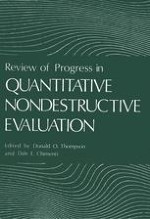1983 | OriginalPaper | Chapter
Application of Ultrasonic Spectroscopy to Scattering of Rayleigh Wave in a Half-Space
Authors : Bien Q. Vu, Vikram K. Kinra
Published in: Review of Progress in Quantitative Nondestructive Evaluation
Publisher: Springer US
Included in: Professional Book Archive
Activate our intelligent search to find suitable subject content or patents.
Select sections of text to find matching patents with Artificial Intelligence. powered by
Select sections of text to find additional relevant content using AI-assisted search. powered by
The scattering of Rayleigh surface waves by a variety of defects has been experimentally studied by the use of ultrasonic spectroscopy in the frequency range of 1 – 10 MHz. The defects are: (1) a through edge crack, both normal and inclined; (2) a cavity; (3) four different fluid inclusions, namely, carbon tetrachloride, water, mercury, and glycerine; (4) a solid inclusion; and (5) a shell. The transmission coefficient, AT, defined as the total transmitted field normalized with respect to the incident field, is calculated from the FFT of the two signals. (The receiver is located sufficiently far away from the defect so that it only senses the far-field.) Whenever possible, the phase difference caused by the presence of the defect, ⌽, is also measured. The spectroscopic measurements were verified by the more accurate (albeit far more time consuming) tone-burst method. The classical problem of a quarter-space was used as a test case. The experimental results were found to be in excellent agreement with some of the recent analyses.It is concluded that ultrasonic spectroscopy can be used as an efficient NDTE tool. In particular, the “signature” of a variety of inclusions is shown to be quite distinct, a fact that should prove very useful from the viewpoint of the inversion problem.
